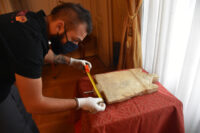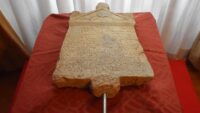 A Lydian-era inscribed marble stele has been repatriated to Turkey almost three decades after it was illegally exported from the country. The inscription was looted in the early 1990s from the Temple of Apollo Aksyros in the ancient Lydian city of Saittai, today in the province of Manisa in western Turkey. In 1997, the stele was discovered in a raid on an antique shop in Florence. Italy’s Cultural Patrimony police confirmed its origin with Turkish Interpol, but because the open-air site has not been systematically excavated and documented, there was no hard evidence that it had been stolen and smuggled out of the country illegally.
A Lydian-era inscribed marble stele has been repatriated to Turkey almost three decades after it was illegally exported from the country. The inscription was looted in the early 1990s from the Temple of Apollo Aksyros in the ancient Lydian city of Saittai, today in the province of Manisa in western Turkey. In 1997, the stele was discovered in a raid on an antique shop in Florence. Italy’s Cultural Patrimony police confirmed its origin with Turkish Interpol, but because the open-air site has not been systematically excavated and documented, there was no hard evidence that it had been stolen and smuggled out of the country illegally.
Turkey’s Culture and Tourism Ministry spent the next 23 years pressing its claim in the Italian courts. On November 5th, 2019, the Florence Court of Appeal finally ruled that Turkey was the legal owner of the inscription triggering the repatriation process. After much diplomatic back-and-forth (and COVID-related delays), the stele was officially handed over to Murat Saim Esenli, Turkish Ambassador to Rome, on September 19th.
 The ancient text itself points to its find site. It is an atonement inscription, a public allocution meant to expiate a sin. In this case, the sins of the children were visited upon the parents.
The ancient text itself points to its find site. It is an atonement inscription, a public allocution meant to expiate a sin. In this case, the sins of the children were visited upon the parents.
“Melita and Makedon stole Eia’s fishnet and other belongings. Therefore, they were punished by God. Their parents consulted Apollon Aksyros for their sake and made a vow.”
Saittai was one of the 10 cities in the Katakekaumene decapolis, a political union which prospered in the Hellenistic and Roman eras. It had its own mint under Roman rule and at least one emperor, Hadrian, visited it in person. It had temples to several deities, Apollon Aksyros among them. The date of the inscription is not known, but by the 5th century Saittai was the seat of a Christian bishopric and the ancient temples were no longer in active use.
The stele will go on display at the Anatolian Civilizations Museum in Ankara.
Note that a few sins might have been omitted here. The first three lines read: “[…] etou stmzan[? apparently verbal] dikou dodeka tedia toa amartema to epoiesan epi to theo kai ek…” and they appear to be Greek: “dodeka tedia toa amartema” I would read as “here twelve sins” and “to epoiesan epi to theo” as “they made to the god”, while “Melita and Makedon” then follow in the eighth[!] line.
In case the open-air site has not been “systematically excavated and documented”, I do in fact have about 200 of Grampa’s dia slides from over 60 years ago taken in western Turkey. The other day, I got a cheap dia scanner, but honestly have no idea about the sites themselves (one of them seems to be in Ephesos). There even is what looks like a Lydian atonement inscription: “i.imgur.com/4a0XOM6.jpg”.
i.imgur.com/2q4Fy8O.jpg
i.imgur.com/5UeGBO7.jpg
i.imgur.com/NZ1l1u3.jpg
i.imgur.com/yJ8UHcH.jpg
i.imgur.com/lbQXa1w.jpg
i.imgur.com/WSBUMC9.jpg
i.imgur.com/iK6nlHS.jpg
i.imgur.com/V16ACAK.jpg
i.imgur.com/I8mL8zi.jpg
i.imgur.com/WZzv0K0.jpg
i.imgur.com/FKqeAzL.jpg
i.imgur.com/UFHmZQx.jpg
… etc.
Nice, Helen, once I figured out how to find the links by putting “https://” in front of them :boogie: